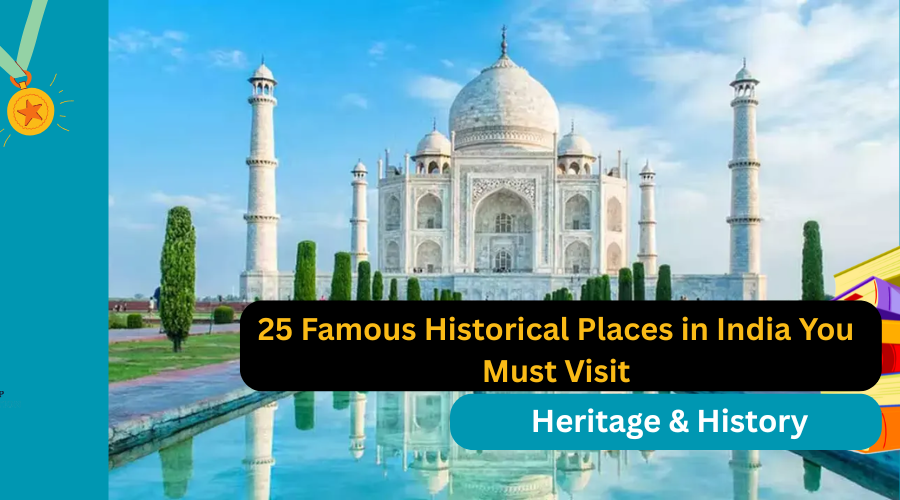India, often referred to as the land of ancient civilizations, is a treasure trove of history and culture. With roots stretching back over 5,000 years, the country is dotted with magnificent monuments, ancient ruins, royal forts, grand temples, and colonial-era buildings that narrate tales of empires, spirituality, and artistry. From the architectural marvels of the Mughals and Cholas to the enduring legacies of Buddhist stupas and colonial landmarks, India offers an extraordinary glimpse into its past through its heritage sites.
Whether you\’re a passionate traveler, a history enthusiast, or someone planning your next cultural journey, exploring these famous historical places in India is a must. This blog curates a list of 25 iconic sites—each representing a unique chapter of Indian history—spread across different states, cultures, and time periods.
Let’s step into the past and explore the best of India’s architectural legacy and historical richness.
25 Famous Historical Places in India
1. Taj Mahal, Agra – Uttar Pradesh
Overview
The Taj Mahal, built in the 17th century by Mughal Emperor Shah Jahan in memory of his wife Mumtaz Mahal, is India’s most iconic symbol of love and architectural brilliance. This white marble mausoleum blends Persian, Islamic, and Indian styles and is adorned with intricate carvings and symmetrical gardens. Recognized as a UNESCO World Heritage Site, it is one of the most visited historical places in India and a marvel of Mughal craftsmanship.
Key Highlights
- Architectural Style: Mughal (Persian + Indian)
- Built: 1632–1653 by Shah Jahan
- UNESCO World Heritage Site
- Entry Timings: Sunrise to Sunset (Closed on Fridays)
- Best Time to Visit: November to March
2. Red Fort, Delhi
Overview
Commissioned by Emperor Shah Jahan in 1638, the Red Fort (Lal Qila) served as the main residence of the Mughal emperors for nearly 200 years. This grand red sandstone structure is a symbol of India\’s sovereignty, where the Prime Minister hoists the national flag each Independence Day. Its blend of Persian, Timurid, and Indian architectural styles makes it one of the finest examples of Mughal fort design.
Key Highlights
- Architectural Style: Indo-Islamic (Mughal)
- Built: 1638–1648
- UNESCO World Heritage Site
- Entry Timings: 9:30 AM to 4:30 PM (Closed on Mondays)
- Best Time to Visit: October to February
3. Qutub Minar, Delhi
Overview
The Qutub Minar, a 73-meter-high tower made of red sandstone, is one of the tallest brick minarets in the world. Initiated by Qutb-ud-din Aibak in 1192 and completed by later rulers, it marks the beginning of Muslim rule in India. Surrounded by the Qutub Complex, including the Quwwat-ul-Islam Mosque and the Iron Pillar, the site offers insights into early Indo-Islamic architecture.
Key Highlights
- Architectural Style: Indo-Islamic
- Built: 12th century onwards
- UNESCO World Heritage Site
- Entry Timings: 7:00 AM to 5:00 PM (Open daily)
- Best Time to Visit: October to March
4. Hampi, Karnataka
Overview
Hampi, once the capital of the Vijayanagara Empire, is a vast open-air museum of ancient temples, market streets, and royal enclosures. Located along the Tungabhadra River, its ruins date back to the 14th century and reflect the zenith of Dravidian architecture. A UNESCO World Heritage Site, Hampi is both spiritually significant and architecturally magnificent, making it one of the most mesmerizing ancient places in India.
Key Highlights
- Architectural Style: Vijayanagara (Dravidian)
- Flourished: 14th–16th century
- UNESCO World Heritage Site
- Entry Timings: Sunrise to Sunset
- Best Time to Visit: October to February
5. Fatehpur Sikri, Uttar Pradesh
Overview
Fatehpur Sikri was founded by Emperor Akbar in 1571 as the capital of the Mughal Empire. Built entirely in red sandstone, it served as the royal city for just over a decade before being abandoned due to water scarcity. The city includes majestic buildings like Buland Darwaza, Jama Masjid, and the palace of Jodha Bai, offering a glimpse into Akbar’s architectural vision and secular governance.
Key Highlights
- Architectural Style: Indo-Islamic-Mughal
- Built: 1571–1585 by Akbar
- UNESCO World Heritage Site
- Entry Timings: 6:00 AM to 6:00 PM
- Best Time to Visit: November to February
6. Amer Fort, Jaipur – Rajasthan
Overview
Located just outside Jaipur, Amer Fort (also spelled Amber Fort) is a magnificent example of Rajput architecture blended with Mughal design. Built by Raja Man Singh I in the 16th century, the fort is known for its ornate palaces, intricate mirror work in the Sheesh Mahal, and elephant rides up the cobbled path. Overlooking Maota Lake, Amer Fort is a stunning testament to Rajasthan’s royal heritage.
Key Highlights
- Architectural Style: Rajput-Mughal
- Built: 1592 by Raja Man Singh I
- UNESCO Tentative List
- Entry Timings: 8:00 AM to 5:30 PM
- Best Time to Visit: October to March
7. Mehrangarh Fort, Jodhpur – Rajasthan
Overview
Towering over the Blue City of Jodhpur, Mehrangarh Fort is one of India’s largest and most formidable forts. Founded by Rao Jodha in 1459, it rises 400 feet above the city and houses several palaces, courtyards, and museums. The fort’s thick walls, breathtaking views, and detailed carvings make it an architectural and historical marvel, offering visitors a glimpse into Marwar’s royal past.
Key Highlights
- Architectural Style: Rajput
- Built: 1459 by Rao Jodha
- Entry Timings: 9:00 AM to 5:00 PM
- Best Time to Visit: October to February
- Museum showcases weapons, costumes, and artwork
8. Gateway of India, Mumbai – Maharashtra
Overview
The Gateway of India, built in 1924, stands as a majestic colonial-era archway facing the Arabian Sea. Constructed to commemorate the visit of King George V and Queen Mary to India, it later became a symbolic exit point for British troops during independence. Today, it’s one of Mumbai’s most visited historical landmarks and a popular gathering spot for locals and tourists alike.
Key Highlights
- Architectural Style: Indo-Saracenic
- Built: 1913–1924
- Entry Timings: Open 24×7 (no entry fee)
- Best Time to Visit: November to February
- Located near: Taj Mahal Palace Hotel, Mumbai
9. Sun Temple, Konark – Odisha
Overview
The Konark Sun Temple, built in the 13th century by King Narasimhadeva I, is a masterpiece of Kalinga architecture. Designed in the shape of a colossal chariot dedicated to the Sun God Surya, it features 24 carved wheels and seven horses. This UNESCO World Heritage Site is admired for its architectural grandeur, erotic sculptures, and symbolic astronomical alignment.
Key Highlights
- Architectural Style: Kalinga (Eastern Indian temple style)
- Built: 1250 CE by Narasimhadeva I
- UNESCO World Heritage Site
- Entry Timings: 6:00 AM to 8:00 PM
- Best Time to Visit: November to February
10. Khajuraho Temples, Madhya Pradesh
Overview
The Khajuraho Group of Monuments is a collection of Hindu and Jain temples built between 950 and 1050 AD by the Chandela dynasty. Known for their intricate carvings and famous erotic sculptures, the temples reflect India\’s rich artistic heritage. Only about 20 of the original 85 temples remain today, and they form one of the finest examples of Nagara-style architecture.
Key Highlights
- Architectural Style: Nagara (North Indian temple style)
- Built: 10th–11th century by the Chandelas
- UNESCO World Heritage Site
- Entry Timings: Sunrise to Sunset
- Best Time to Visit: October to March
11. Sanchi Stupa, Madhya Pradesh
Overview
The Great Stupa at Sanchi is one of the oldest stone structures in India, originally commissioned by Emperor Ashoka in the 3rd century BCE. This Buddhist monument enshrines relics of the Buddha and represents a major turning point in early Indian architecture. The elaborately carved gateways (toranas) depict scenes from the Buddha’s life and teachings, making Sanchi a sacred and historically significant site for pilgrims and tourists alike.
Key Highlights
- Architectural Style: Buddhist–Mauryan
- Built: 3rd century BCE by Ashoka the Great
- UNESCO World Heritage Site
- Entry Timings: Sunrise to Sunset (Open all days)
- Best Time to Visit: October to March
12. Charminar, Hyderabad – Telangana
Overview
Built in 1591 by Sultan Muhammad Quli Qutb Shah, Charminar is the most recognized monument in Hyderabad and a symbol of the city. The name literally means \”Four Minarets,\” and it served as both a mosque and a ceremonial gateway. Located in the heart of the old city, Charminar is surrounded by lively bazaars and is a blend of Islamic and Persian architectural influences.
Key Highlights
- Architectural Style: Indo-Islamic
- Built: 1591 by Muhammad Quli Qutb Shah
- Entry Timings: 9:30 AM to 5:30 PM
- Best Time to Visit: October to February
- Nearby Attraction: Laad Bazaar (famous for bangles)
13. Golconda Fort, Telangana
Overview
The Golconda Fort, originally built by the Kakatiyas in the 13th century and later expanded by the Qutb Shahi dynasty, is a fascinating military structure known for its acoustic design and strategic layout. Once famed for its diamond trade—including the Kohinoor—Golconda offers panoramic views, historic gateways, and a sound-and-light show that revives its royal past.
Key Highlights
- Architectural Style: Military-Islamic
- Expanded: 16th century by Qutb Shahis
- Entry Timings: 9:00 AM to 5:30 PM
- Best Time to Visit: November to February
- Sound & Light Show: Available in the evening
14. Ajanta & Ellora Caves, Maharashtra
Overview
Located in the Aurangabad district, the Ajanta and Ellora Caves are UNESCO World Heritage Sites that reflect the spiritual and artistic evolution of Indian civilization. Ajanta houses Buddhist frescoes and sculptures from the 2nd century BCE, while Ellora features rock-cut temples from Hinduism, Buddhism, and Jainism, including the magnificent Kailasa Temple carved from a single rock.
Key Highlights
- Ajanta: Buddhist caves (2nd BCE–6th CE)
- Ellora: Hindu, Jain, and Buddhist (6th–10th CE)
- UNESCO World Heritage Sites
- Entry Timings: 9:00 AM to 5:30 PM (Closed on Tuesdays – Ajanta; Closed on Mondays – Ellora)
- Best Time to Visit: November to March
15. Mahabalipuram Temples, Tamil Nadu
Overview
Mahabalipuram (also known as Mamallapuram) is an ancient port city known for its rock-cut temples, shore temple, and sculptural reliefs. Built by the Pallava kings in the 7th and 8th centuries, the site is a UNESCO World Heritage Site and reflects early Dravidian architectural experimentation in stone. Highlights include the Five Rathas and the massive bas-relief known as Arjuna’s Penance.
Key Highlights
- Architectural Style: Dravidian rock-cut
- Built: 7th–8th century by Pallava kings
- UNESCO World Heritage Site
- Entry Timings: 6:00 AM to 6:00 PM
- Best Time to Visit: November to February
16. Brihadeeswarar Temple, Thanjavur – Tamil Nadu
Overview
Built by Raja Raja Chola I in the 11th century, the Brihadeeswarar Temple is a shining example of Chola architecture and one of the most majestic temples in India. Dedicated to Lord Shiva, this UNESCO World Heritage Site is known for its towering vimana (temple tower), which rises to a height of over 200 feet, and its massive Nandi statue carved from a single stone.
Key Highlights
- Architectural Style: Dravidian (Chola Dynasty)
- Built: 1010 AD by Raja Raja Chola I
- UNESCO World Heritage Site
- Entry Timings: 6:00 AM to 12:30 PM, 4:00 PM to 8:30 PM
- Best Time to Visit: October to March
17. Gwalior Fort, Madhya Pradesh
Overview
The imposing Gwalior Fort, perched atop a steep hill, has stood as a guardian over central India since the 8th century. Often described as “the pearl among fortresses,” it has been ruled by several dynasties, including the Tomars, Mughals, and Marathas. Inside, visitors will find palaces, temples, and inscriptions, including one of the earliest known uses of the numeral “zero.”
Key Highlights
- Architectural Style: Rajput-Mughal fusion
- Earliest Reference: 8th century AD
- Entry Timings: 8:00 AM to 6:00 PM
- Best Time to Visit: October to February
- Notable Spots: Man Singh Palace, Saas-Bahu Temples
18. Rani ki Vav, Patan – Gujarat
Overview
Rani ki Vav, or the Queen’s Stepwell, is an intricately designed stepwell built in the 11th century by Queen Udayamati in memory of King Bhimdev I. Recognized as a UNESCO World Heritage Site, the seven-level structure features over 1,500 finely carved sculptures of gods, goddesses, and mythological figures, exemplifying the height of Maru-Gurjara architectural style.
Key Highlights
- Architectural Style: Maru-Gurjara (Solanki era)
- Built: 11th century by Queen Udayamati
- UNESCO World Heritage Site
- Entry Timings: 8:00 AM to 6:00 PM
- Best Time to Visit: October to February
19. Jantar Mantar, Jaipur – Rajasthan
Overview
The Jantar Mantar in Jaipur is an astronomical observatory built in the 18th century by Maharaja Sawai Jai Singh II. Housing the world’s largest stone sundial, it showcases the scientific and architectural prowess of ancient India. The observatory was used to measure time, track celestial bodies, and predict eclipses with remarkable precision.
Key Highlights
- Architectural Style: Scientific-astronomical
- Built: 1724 by Sawai Jai Singh II
- UNESCO World Heritage Site
- Entry Timings: 9:00 AM to 5:00 PM
- Best Time to Visit: October to March
20. Victoria Memorial, Kolkata – West Bengal
Overview
Commissioned in memory of Queen Victoria, the Victoria Memorial is one of Kolkata’s most prominent colonial landmarks. Constructed between 1906 and 1921, this white marble structure is surrounded by lush gardens and houses a museum showcasing British-era paintings, manuscripts, and artifacts. Its Indo-Saracenic style bridges Mughal and European elements.
Key Highlights
- Architectural Style: Indo-Saracenic Revival
- Built: 1906–1921
- Entry Timings: 10:00 AM to 5:00 PM (Closed Mondays)
- Museum & Art Gallery inside
- Best Time to Visit: November to February
21. Chittorgarh Fort, Rajasthan
Overview
The Chittorgarh Fort is the largest fort in India and a powerful symbol of Rajput valor, sacrifice, and resistance. Spread over 700 acres, the fort has witnessed legendary acts of bravery and Jauhar, including that of Rani Padmini. Built in the 7th century, it houses grand palaces, ancient temples, and towers that narrate the stories of battles fought for honor and pride.
Key Highlights
- Architectural Style: Rajput
- Built: 7th century by Maurya rulers
- UNESCO World Heritage Site (Hill Forts of Rajasthan)
- Entry Timings: 9:00 AM to 5:00 PM
- Best Time to Visit: October to February
22. Mysore Palace, Karnataka
Overview
The Mysore Palace, also known as the Amba Vilas Palace, is the epitome of royal grandeur and cultural richness. Once the seat of the Wodeyar dynasty, it blends Hindu, Mughal, Gothic, and Rajput styles. The palace is illuminated with over 97,000 bulbs during Dussehra, creating a mesmerizing view and drawing thousands of visitors from across the world.
Key Highlights
- Architectural Style: Indo-Saracenic
- Built: 1912 (reconstructed after fire)
- Entry Timings: 10:00 AM to 5:30 PM
- Dussehra Illumination: Evening spectacle
- Best Time to Visit: September to March
23. Lothal, Gujarat
Overview
Lothal is one of the most prominent cities of the Indus Valley Civilization, offering deep insights into early urban planning and maritime trade. Located near the Gulf of Khambhat, it features a well-planned dockyard, a drainage system, and remnants of warehouses and workshops. Dating back to 2400 BCE, Lothal is a key archaeological site reflecting India’s ancient technological advancement.
Key Highlights
- Civilization: Indus Valley (Harappan)
- Time Period: ~2400 BCE
- Entry Timings: 9:00 AM to 5:00 PM (Closed Fridays)
- Best Time to Visit: November to February
- Site Managed by: Archaeological Survey of India
24. Sarnath, Uttar Pradesh
Overview
Located just outside Varanasi, Sarnath is the sacred site where Lord Buddha delivered his first sermon after attaining enlightenment. It features ancient stupas, monasteries, and the Ashoka Pillar with the Lion Capital—India’s national emblem. Sarnath is one of the four main pilgrimage sites for Buddhists and holds great spiritual and archaeological significance.
Key Highlights
- Religious Significance: First Sermon of Buddha
- Notable Structures: Dhamek Stupa, Mulagandha Kuti Vihar, Ashoka Pillar
- Entry Timings: Sunrise to Sunset
- Best Time to Visit: October to March
25. Nalanda University Ruins, Bihar
Overview
Founded in the 5th century CE, Nalanda was one of the world’s first residential universities and a renowned center for Buddhist learning. It attracted scholars from China, Korea, Tibet, and beyond. The expansive ruins include monasteries, lecture halls, stupas, and temples, offering a glimpse into ancient India\’s academic brilliance.
Key Highlights
- Established: 5th century CE (Gupta Empire)
- UNESCO World Heritage Site
- Entry Timings: 9:00 AM to 5:00 PM (Closed Fridays)
- Best Time to Visit: October to March
- Nearby Attraction: Nalanda Archaeological Museum
Conclusion
India’s historical landscape is vast and incredibly diverse, offering a rich blend of ancient wisdom, royal grandeur, architectural mastery, and spiritual depth. From the timeless beauty of the Taj Mahal to the scholarly ruins of Nalanda, each monument tells a story of the country\’s cultural evolution over millennia. Whether you\’re a history enthusiast, student, or curious traveler, these 25 famous historical places in India are must-visits that will deepen your appreciation of the country’s rich legacy. Start your journey into the past and rediscover India—one site at a time.
Frequently Asked Questions (FAQs)
1. Which is the most visited historical place in India?
The Taj Mahal in Agra is the most visited historical site in India, attracting millions of domestic and international tourists each year.
2. Are all these historical places open to tourists year-round?
Yes, most of these sites are open throughout the year, although timings and weekly closures (like Red Fort on Mondays, Taj Mahal on Fridays) may vary. The best time to visit is generally from October to March.
3. Do I need tickets to enter these monuments?
Yes, most sites charge a nominal entry fee. Indian citizens often pay a lower fee compared to foreign tourists. Some sites offer free entry for children under 15 or during special government-announced days.
4. Are guided tours available at these places?
Absolutely. Guided tours and audio guides are available at most UNESCO sites and major historical monuments. Hiring a certified guide can enrich your experience with deeper insights.
5. Which historical site is best for students or educational trips?
Sanchi Stupa, Nalanda, Khajuraho, Hampi, and Mahabalipuram are great for students as they offer significant historical, architectural, and cultural learning experiences.
6. Are these places accessible to elderly travelers or people with disabilities?
Many sites have made efforts to improve accessibility, but since some are ancient structures (like forts and caves), wheelchair access may be limited. Always check in advance with official tourism websites.





